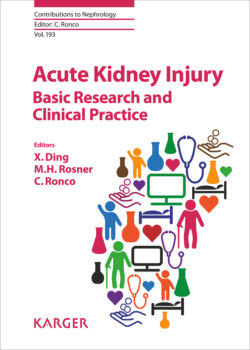Читать книгу Acute Kidney Injury - Basic Research and Clinical Practice - Группа авторов - Страница 17
На сайте Литреса книга снята с продажи.
An Outlook to the Future: AKI Biomarkers and Subclinical AKI
ОглавлениеIn order to overcome some of the limitations of SCr and UO, a variety of functional and damage biomarkers have been identified and validated in humans [28, 29] as tools to diagnose AKI earlier than traditional tests and prognosticate outcomes. Despite their potential to detect the development of AKI prior to an SCr rise (subclinical AKI), no clear benefit on patients’ outcome has been demonstrated so far. Among them, Cystatin C, Neutrophil Gelatinase-Associated Lipocalin, and markers of cell cycle arrest (tissue inhibitor of metalloproteinase-2 and insulin-like growth factor binding protein-7) are now commercially available and their role in future AKI diagnosis and classification systems still has to be evaluated. For example, Cystatin C is less affected by muscle mass and may outperform SCr for the detection of decreased GFR in critically ill patients [21]. The association of (tissue inhibitor of metalloproteinase-2) and (insulin-like growth factor binding protein-7; Nephrocheck, Astute Medical, San Diego, CA, USA) showed good performance in identifying patients at risk of AKI after cardiac surgery with a threshold value >0.3. These patients have taken advantage from the close application of “KDIGO bundles” consisting of optimization of volume status and hemodynamics, avoidance of nephrotoxic drugs, and preventing hyperglycemia [30]. Definitely, positive clues from the literature are coming up but whether the use of biomarkers may impact clinical decisions and contribute to better prevention and management of AKI remains to be proven.
